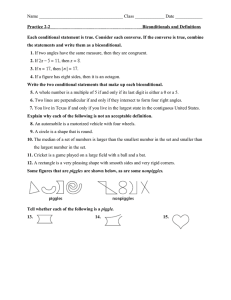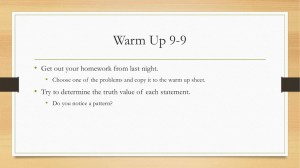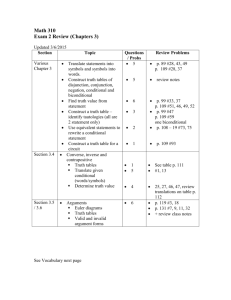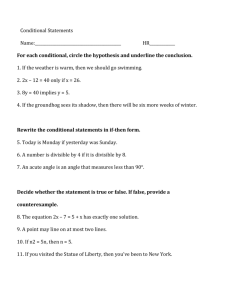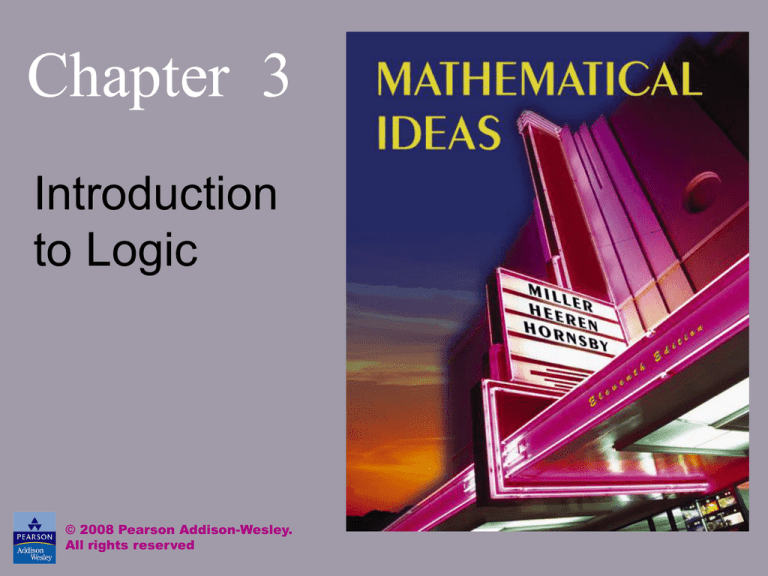
Chapter 3
Introduction
to Logic
© 2008 Pearson Addison-Wesley.
All rights reserved
Chapter 3: Introduction to Logic
3.1
3.2
3.3
3.4
3.5
3.6
Statements and Quantifiers
Truth Tables and Equivalent Statements
The Conditional and Circuits
More on the Conditional
Analyzing Arguments with Euler Diagrams
Analyzing Arguments with Truth Tables
© 2008 Pearson Addison-Wesley. All rights reserved
3-4-2
Chapter 1
Section 3-4
More on the Conditional
© 2008 Pearson Addison-Wesley. All rights reserved
3-4-3
More on the Conditional
•
•
•
•
Converse, Inverse, and Contrapositive
Alternative Forms of “If p, then q”
Biconditionals
Summary of Truth Tables
© 2008 Pearson Addison-Wesley. All rights reserved
3-4-4
Converse, Inverse, and Contrapositive
Conditional
Statement
Converse
pq
If p, then q
q p
If q, then p
Inverse
p q
Contrapositive
q p
© 2008 Pearson Addison-Wesley. All rights reserved
If not p, then
not q
If not q, then
not p
3-4-5
Example: Determining Related
Conditional Statements
Given the conditional statement
If I live in Wisconsin, then I shovel snow,
determine each of the following:
a) the converse b) the inverse c) the contrapositive
Solution
a) If I shovel snow, then I live in Wisconsin.
b) If I don’t live in Wisconsin, then I don’t shovel
snow.
c) If I don’t shovel snow, then I don’t live in
Wisconsin.
© 2008 Pearson Addison-Wesley. All rights reserved
3-4-6
Equivalences
A conditional statement and its contrapositive
are equivalent, and the converse and inverse
are equivalent.
© 2008 Pearson Addison-Wesley. All rights reserved
3-4-7
Alternative Forms of “If p, then q”
The conditional p q can be translated in
any of the following ways.
If p, then q.
p is sufficient for q.
If p, q.
q is necessary for p.
p implies q.
All p are q.
p only if q.
q if p.
© 2008 Pearson Addison-Wesley. All rights reserved
3-4-8
Example: Rewording Conditional
Statements
Write each statement in the form “if p, then q.”
a) You’ll be sorry if I go.
b) Today is Sunday only if yesterday was Saturday.
c) All Chemists wear lab coats.
Solution
a) If I go, then you’ll be sorry.
b) If today is Sunday, then yesterday was Saturday.
c) If you are a Chemist, then you wear a lab coat.
© 2008 Pearson Addison-Wesley. All rights reserved
3-4-9
Biconditionals
The compound statement p if and only if q
(often abbreviated p iff q) is called a
biconditional. It is symbolized p q , and
is interpreted as the conjunction of the two
conditionals p q and q p.
© 2008 Pearson Addison-Wesley. All rights reserved
3-4-10
Truth Table for the Biconditional
p if and only if q
q
pq
T
T
T
T
F
F
F
T
F
F
F
T
p
© 2008 Pearson Addison-Wesley. All rights reserved
3-4-11
Example: Determining Whether
Biconditionals are True or False
Determine whether each biconditional statement is true
or false.
a) 5 + 2 = 7 if and only if 3 + 2 = 5.
b) 3 = 7 if and only if 4 = 3 + 1.
c) 7 + 6 = 12 if and only if 9 + 7 = 11.
Solution
a) True (both component statements are true)
b) False (one component is true, one false)
c) True (both component statements are false)
© 2008 Pearson Addison-Wesley. All rights reserved
3-4-12
Summary of Truth Tables
1. The negation of a statement has truth value
opposite of the statement.
2. The conjunction is true only when both
statements are true.
3. The disjunction is false only when both
statements are false.
4. The biconditional is true only when both
statements have the same truth value.
© 2008 Pearson Addison-Wesley. All rights reserved
3-4-13

